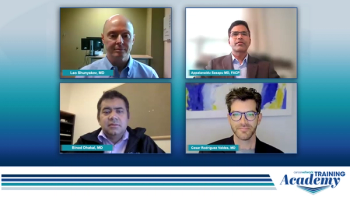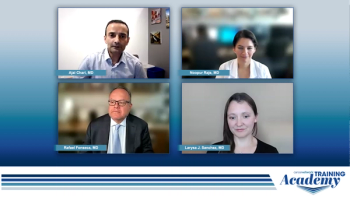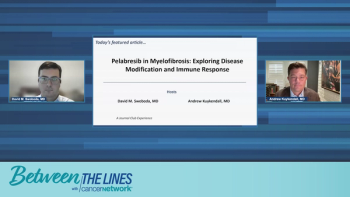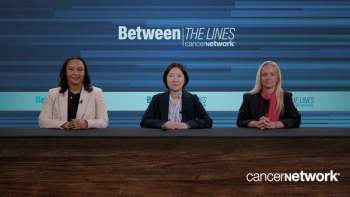
Ultra-hypofractionated radiation in those 65 years or older with early breast cancer yielded no ipsilateral recurrence after a 10-month follow-up.

Your AI-Trained Oncology Knowledge Connection!


Ultra-hypofractionated radiation in those 65 years or older with early breast cancer yielded no ipsilateral recurrence after a 10-month follow-up.

The unclear role of hypofractionated radiation in older patients with early breast cancer in prior trials incentivized research for this group.

Panelists discuss how streamlining the referral process for multiple myeloma patients can significantly reduce treatment initiation.

Panelists discuss how effective collaboration, care coordination, and communication between academic and community physicians are crucial for ensuring seamless transitions and high-quality care for patients with multiple myeloma.

The panel provides an overview of REMS programs for bispecific therapies in multiple myeloma and discusses how institutions can educate healthcare professionals outside of oncology.

Experts on multiple myeloma discuss prophylactic supportive measures to prevent CRS and ICANS in patients who receive GPRC5D therapy.

Noopur Raje, MD, discusses the role of T-cell affinity in bispecific therapy for patients with relapsed/refractory multiple myeloma and how it impacts treatment practices.

The panel discusses the benefits of having multiple BCMA-targeting bispecifics available for patients with relapsed/refractory multiple myeloma.

Medical experts describe the decision-making process between choosing an IO-IO vs an IO-TKI regimen for first-line treatment, considering factors such as safety profile and response in both community and academic settings.

Medical experts will discuss the updated NCCN guidelines favoring ipilimumab + plus nivolumab for patients with favorable risk, including the data supporting this change and its the potential impact on the disease landscape.

The discussion shares key takeaways and practical insights for optimizing the referral and treatment process for CAR T-cell and bispecific therapies.

The discussion focuses on protocols for monitoring long-term complications from CAR T-cell and bispecific therapies, improving patient reintegration into community care posttreatment, and enhancing communication between academic and community oncologists.

Panelists discuss how patient selection for GPRC5D-targeted therapies in the relapsed/refractory setting is guided by factors such as prior treatment history, including the number and types of previous therapies, with special consideration given to patients who have exhausted other options or shown resistance to earlier lines of treatment.

Panelists discuss how certain patient subgroups, such as those with high-risk cytogenetics or extramedullary disease, may experience different outcomes with GPRC5D bispecific therapies, though more data is needed to draw definitive conclusions about subgroup-specific responses.

Thomas G. Martin, MD, reviews findings from a pooled analysis from MagnetisMM that evaluated elranatamab in patients with relapsed/refractory MM who received prior BCMA-directed therapies.

Panelists discuss disease-modifying biomarker data from the MANIFEST-2 study investigating pelabresib in myelofibrosis.

Adding bortezomib to Isa-Rd triplet therapy enhanced MRD-negative responses in patients with transplant-ineligible multiple myeloma.

Panelists discuss the safety profile of the pelabresib and ruxolitinib combination in myelofibrosis.

Isatuximab plus VRd triplet therapy did not significantly increase toxicity in patients with transplant-ineligible multiple myeloma in the IMROZ trial.

Isatuximab quadruplet therapy for patients with multiple myeloma prolonged progression-free survival when compared with VRd triplet therapy.

Retrospective study data show that patients with inflammatory bowel disease may not require modification of standard radiotherapy for pelvic malignancies.

Prospective trial data may help guide treatment planning for patients with inflammatory bowel disease planning to undergo radiotherapy.

Samantha Shenoy, NP, MSN, suggests that support groups may help comfort patients experiencing adverse effects negatively impacting quality of life.


Panelists discuss how amivantamab, FDA approved for first-line treatment of advanced non–small cell lung cancer with specific EGFR mutations, can lead to significant infusion-related reactions, including serious cases that may require dose adjustments or discontinuation.

Panelists discuss insights from the MARIPOSA study on first-line treatment options for EGFR-mutant metastatic non–small cell lung cancer (NSCLC), highlighting the efficacy of amivantamab-lazertinib over osimertinib, the importance of managing adverse events, adherence to National Comprehensive Cancer Network guidelines, and the need for patient engagement in treatment discussions to address unmet needs.

Uterine transposition is a newer tactic in the surgical oncology field to help preserve fertility for patients undergoing pelvic radiation.

Samantha Shenoy, NP, MSN, emphasized educating patients with multiple myeloma to help prepare them for potential taste alterations after talquetamab.

Samantha Shenoy, NP, MSN, indicated that neurological issues were not prevalent with talquetamab, despite occurrences with other bispecifics antibodies.

Panelists discuss how GPRC5D bispecific therapies have shown promising efficacy in real-world relapsed/refractory multiple myeloma patients.